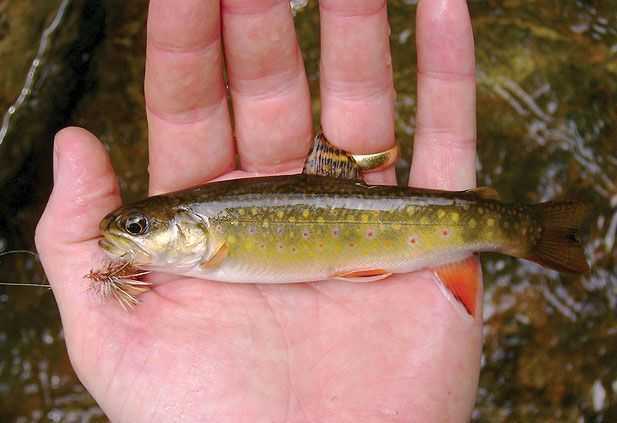Between Murphy, North Carolina and the tiny little town of Andrews, there is a long stretch of U.S. 129 that curves gently through the lowland fields and farms along the Valley River. The Snowbird Mountains roll up abruptly on all sides to form a gorgeously stark barrier from the softness of valley below. As the strip malls fade out of the rearview mirror, the road dives headlong into a cleft, climbing miles of sharp switchbacks to dump you unceremoniously into a haggard little outpost called Robbinsville, N.C.
Nearly a hundred miles from the nearest commercially serviced airport, in this almost forgotten, mountainous western tip of the state, you will find a stronghold of the southern Appalachian brook trout. These diminutive little beauties, which have been extirpated from nearly half the watersheds they were native to, have maintained a foothold in the high-elevation trickles that lie like a web over the Snowbird Mountains.
Over centuries, southern Appalachian brook trout—known as “specks” by the locals—have been beaten back by poor land management practices and the introduction of non-native species, notably brown and rainbow trout. All four Southeastern states within the brook trout’s native range—Georgia, Tennessee, North Carolina and South Carolina—are conducting habitat improvements and reintroductions of this native strain. But for anglers, the adventure involved in finding specks is as much fun as catching them. They live in some of the most beautiful places on earth.
This is the Southeast’s version of fishing high-elevation Rocky Mountain beaver ponds for native cutthroats. The hikes in are often long and grueling, and the fish are typically a fraction of the size you’ll find on the larger, usually stocked flows closer to civilization. But for anglers with an appreciation for pretty fish and the feeling of solitude that comes with hiking farther into the woods than most are willing, it can be worth it.
Some people call it blue-lining. Get out a good topo map of a mountainous area with water temperatures capable of supporting trout populations. Look for those thin blue lines that indicate small streams falling from high elevations into known trout waters. These are your likely speck streams. A stream’s elevation loss is key. In order to have productive speck water, there must be a barrier waterfall that prohibits upstream migration of rainbow and brown trout. Brook trout populations do not last long in waters where rainbows or browns have gained a foothold.
These exacting conditions exist in remote locations throughout the speck’s native range. In strictly managed areas, like the Great Smoky Mountains National Park, reintroductions of southern Appalachian brook trout have created easier access to them. This is wonderful, but for some anglers who enjoy the challenge and adventure of blue-lining, it defeats the purpose. Finding and fishing a good speck stream that few others know about is the reward in itself.
Once you do find them, they are typically easy to catch. In the infertile headwaters where they reside, specks are extremely opportunistic feeders. They’ll jump on just about any dry fly or nymph you care to present, and spin-fishermen can catch them on an array of very small jigs and spinners. There really is no need for live bait, and a fly rod is probably better suited for fishing in the thin pocket water where specks live.
If this sounds like a lot of trouble to catch trout that rarely reach lengths longer than 9 to 12 inches, it is. It takes some research. And unless he’s your brother-in-law, don’t even bother asking the guy at the local fly shop where to find specks. Then there’s the searching. Many times finding good speck water is the result of growing bored with the main flow of a river and exploring up small tributaries. Most anglers will never do it.
Here’s a big hint to get you started. Find Big Snowbird Creek in Graham County, N.C. Drive until the road turns to dirt. Bypass all the enticingly gorgeous pocket water that parallels the road. Drive until the road ends, and then hike in about 8 miles to Big Falls. Above Big Falls, specks have been here longer than the Cherokee. In their spawning regalia of deep purple, green and orange, with white tipped fins, they are the most exquisite and delicate of all fish. And that’s what it’s all about

